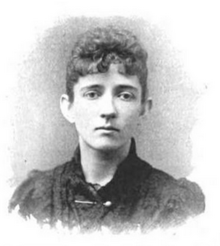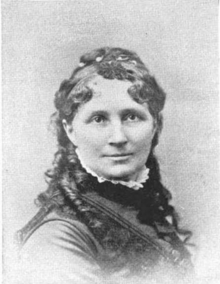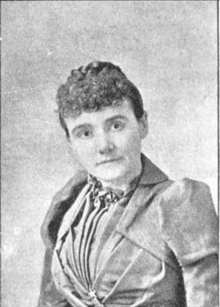Pacific Coast Women's Press Association
Pacific Coast Women's Press Association (PCWPA; September 27, 1890 - 1941) was a press organization for women located on the West Coast of the United States. The purpose of this association was primarily to bring about a more extensive acquaintance among newspaper women, so that by the frequent interchange of ideas and methods, concerted action could be brought about matters of vital public import. Discussions were not permitted of any partisan movements on the subjects of politics, religion, or reform. The members of the association took on causes related to certain public improvements in the way of roads, streets, parks, libraries, village improvement societies, free exhibits of county resources, the suppression of criminal details of sensational cases in newspapers, the suppression of criminal advertising, the development of the kindergartens — things that tended to the building up of the country. To facilitate the work, the association issued printed monographs.
| Abbreviation | PCWPA |
|---|---|
| Formation | September 27, 1890 |
| Founder | Emelie Tracy Y. Swett |
| Founded at | 1941 |
| Headquarters | San Francisco, California |
Main organ | The Impress |
Establishment

Until 1890, no provision had been made on the Pacific Coast for the protection, benefit and advantage of the working newspaper woman and woman author. In other parts of the United States, these associations had been established ever since 1880, most of the earlier ones being organized for purely social purposes.[1]
After nearly three years of preliminary investigation and preparation, 150 invitations were sent out to newspaper women and authors in good standing on the Pacific Coast, asking them to meet in San Francisco, California on September 27, 1890 at the home of Emelie Tracy Y. Swett. Only 50 women came to the meeting, but everyone invited sent letters of encouragement and pledged herself to support the movement.[1]
History
The Constitution and By-Laws of the New England Woman's Press Association was adopted by the PCWPA because of its simplicity.[2] The primary purpose of the PCWPA was to improve relationships among newspaper women of the Pacific Coast, so that through the frequent interchange of ideas and methods, concerted action could be achieved ub matters concerning the public. However, discussions along the lines of any partisan movements on the subjects of politics, religion, or reform were not allowed.[3]
The first year was spent in active organization. A library of several hundred books was accumulated and catalogued, and at the close of the year the Association numbered 125 active members.[4]
The members took on causes related to public improvements in the way of roads, streets, parks, libraries, village improvement societies, free exhibits of county resources, the suppression of criminal details of sensational cases in newspapers, the suppression of criminal advertising, the development of the kindergartens — things that tended to the building up of the country. To facilitate their work, the association issued printed monographs. The first monograph issued was on the topic of "Country Roads and City Streets", written by Mary Lynde Hoffman, a large property owner. Her essay was written from practical knowledge of existing conditions. Hoffman was also a member of the American Economic Association, and her monograph had a considerable circulation through that body. Many leading papers quoted the entire monograph, while others printed long extracts from it, fortified by vigorous editorial comment. More than 500 notices were sent to the Association concerning this essay — a better indication of its success than personal letters could bring.[3]
In its first three years, the only source of income of the Association was that which was derived from membership and initiation fees and from contributions. In time, the association hoped to erect a building in San Francisco, the rentals of which would suffice to pay the running expenses of the Association, as well as sick benefits, when it is required. The library of the Association was a source of gratification to the members. More than 500 volumes were contributed, besides files of many of the leading dailies, weeklies, monthlies. The Association wanted first to accumulate complete sets of the published works of members, then works by Pacific Coast writers, then reference books, and finally, rare and standard books. The organization's librarian was a member of the American Library Association.[5]
Considering that the writing of the general newspaper worker was for the most part anonymous, the organization felt that its ranks do not appear at a disadvantage when compared with those of other press associations. the PCWPA's population was so scattered over a large territory, that it could not show many influential Western newspaper connections. On the other hand, the Western vigor of style had become popular, with nearly all of the writers retaining from one to a half a dozen connections with influential Eastern and English periodicals.[6] As a member of the General Federation of Women's Clubs, the International League of Press Clubs and the Woman's National Press Association, the PCWPA was abreast with the spirit of organization, at the same time confident that responsible individualism was the basis of strength.[7]
The organization did not continue to exist after 1941.[8]
Executive Boards

Emelie Swett Parkhurst founded the association in 1890. Nellie Blessing Eyster was unanimously elected as the first president. The original Executive Board included Jeanne Caroline Smith Carr of Pasadena, First Vice-President; Sarah Brown Ingersoll Cooper, Second Vice-President; Ella Rhoads Higginson of Whatcom, Washington, Third Vice-President; Parkhurst, Corresponding Secretary; Nellie Verrill Mighels Davis of Carson City, Nevada, Recording Secretary; Mary Olmstead Stanton, Treasurer; Isabel H. Raymond of Santa Cruz, California Auditor; and a supplementary committee consisting of Mary Camilla Foster Hall-Wood of Santa Barbara, Frances Bagby-Blades of San Diego and Andrea Hofer of Chicago.[2]

In 1893, Emily Browne Powell was elected president of the association.[9] The Executive Officers for that year, in addition to Powell, included Cooper, First Vice-President; Charlotte Perkins Stetson Gilman, Second Vice-President; Mrs. James Neall, Third Vice-President; Minna V. Gaden, Corresponding Secretary; Mary Lambert, Recording Secretary; Ella M. Sexton, Assistant Recording Secretary; Florence Percy Matheson, Treasurer; Adeline Knapp, Chairman of Program Committee additional; members, Agnes Manning and Lillian Plunkett.[9]
Notable people
Active members in the first year included Caroline Severance, the first president of the first woman's club in Boston; Eliza D. Keith of the San Francisco News Letter; Carrie Stevens Walter, associate owner and editor of the San Josean; Rosa Smith Eigenmann, then of the San Francisco Academy of Sciences; Mary G. Charlton Edholm of the Oakland Tribune and WCTU; Mary Bourne Watson of the Morning Call of San Francisco; Virginia Hilliard of the San Francisco Argus; Mattie P. Owen, editor of the Golden Way; Mary Lambert of the Oakland Enquirer; Mary Bowman, associate editor and owner of the Santa Paula Chronicle; Emeline North, trade and shipping correspondent to Saint Petersburg and Kiev papers; Mary Lynde Hoffman, author of several treatises on road and street construction; Anna C. Murphy, Evelyn Ludlum, Mary Viola Lawrence (Riding Hood), Sarah Sanford, Carrie Blake Morgan, Julia P. Churchill, and Jane Martin.[2]
There was also Isabel Raymond of the Santa Cruz Surf. Of literary distinction was Josephine White Bates (d. 1934). Among the members of the Press Association engaged in editorial work were Genevieve Lucile Browne of the Californian, Louise E. Francis, editor of the Castroville Enterprise, Maggie Downing Brainard of the Pacific Tree and Vine, San Jose, California and Mrs. L. C. P. Haskins of Washington.[10] Among those members who were regular contributors to Eastern and local journals, writing upon California subjects, were a number of Pacific Coast writers by adoption. Helen Gregory-Flesher, a regular contributor to the American Press Association, to the local press, to New York magazines and an occasional contributor to the Arena, was a Canadian by birth and education. Mary F. McRoberts, an Englishwoman, well known in political and educational circles in England, and a contributor to its press from California, was another newcomer to the Pacific Coast, though a resident of California in earlier times.[10] Emma Russell Endres, another English woman, and correspondent to the London Times, was a Californian by her adoption of the State as her home, and a busy contributor to the English and American press. Other members whose largest contribution to the press was for Eastern publications were Carrie Wake Morgan, Alice Cary Waterman, Clara Spalding Brown, and Dorothea Lummis.[7]
Among those prominent in national fame stood Jessie Benton Fremont, who was instrumental in bringing California into the Union as a free State. She was the author of several books: "A Year of Travel," in which she tells of the California gold discovery days; "A Souvenir of My Time," "Stories of the Guard," "A Sketch of Senator Fremont," and "Will and Way Stories." Grace Hibbard, a California poetess, was the author "California Violets." Rose Hartwick Thorpe, author of Curfew Must Not Ring Tonight, had a note from Queen Victoria telling her that she had committed that poem to memory. Anna Morrison Reed, editor of the Northern Crown, was born in the California mines, and was a constant contributor to literature, both prose and poetry. She published one volume of verse through the Bancrofts. Lillian Hinman Shuey, was the author of "California Sunshine","Among the Redwoods," "David of Juniper Gulch," "Don Luis' Wife," and "The Humboldt Lily." Another poetess was Mary Cameron Benjamin.[11]
Kate Douglas Wiggin was well known as a kindergarten worker and as the author of "The Story of Patsy," "The Bird's Christinas Carol," "Timothy's Quest," and other books. Virna Woods gained her first literary reputation in the field of descriptive verse. In 1891 she published a drama entitled "The Amazons," of which Gladstone wrote: "I admire it, both for its poetic force and Hellenic spirit." She was the author of "Horatio," which was produced by Frederick William Ward, and of "Lord Strathmore." She died suddenly in 1902, after having achieved literary success in the dramatic field. Jeanne Caroline Smith Carr (past member of the PCWPA Executive Board), was a constant writer for the general press upon subjects concerning the promotion of the material growth of the State. She was a botanist and artist, a writer and poet, a philanthropist, a political thinker, and a home woman as well. Her name was a household word in Southern California. Mary Catherine McIntire Pacheco, a Kentucky playwright who became one of California's first published women authors, was one of the early successful writers of California. In 1875, her drama, "Betrayed," was produced, and later another trial was made in "Loyal Till Death," a piece which showed distinct merit and great promise. Afterwards, she produced a legitimate farce called "Incog," which was successfully played in the important Eastern cities.[11]
Until 1875, the home of author, Frances Fuller Victor was in Portland, Oregon. After the death of her husband, who was on the ill-fated steamer Pacific when she foundered, Victor came to San Francisco and engaged in historical writing for Bancroft. In 1890, she returned to Ogden, Oregon and wrote "The River of the West," "Sunset at the Mouth of the Columbia," "All Over Oregon and Washington," and many short newspaper and magazine sketches. The voice and pen of Mrs. M. G. C. Edholmes has championed every noble cause, particularly for temperance and social purity, instituted in this State. Sara Plummer Lemmon was a distinguished botanist, and with her husband, was engaged in scientific work. She received a gold medal at the World's Fair for her paintings of wild flowers of the State of California. Alice Kingsbury Cooley, who used to star it with John McCullough and with Keene, is the author of a novel, "Aspah," and is a voluminous writer on many subjects; she is dear "Fanchon," one of the best beloved women of the Association.[11]
Gertrude Francis Atherton, the novelist, was remembered for her keen intellect and power of analysis, making her one of the foremost writers of the day. The literary contributions of Charlotte Perkins Stetson Gilman (past PCWPA Executive Board member), were always accepted by the leading periodicals. She was a niece of Edward Everett Hale. Mary Stanton (past PCWPA Executive Board member), wrote on scientific physiognomy. Nellie Verrill Mighels Davis (past PCPWA Executive Board member), was a practical newspaper woman. Helena Modjeska, whose summer home was near Santa Ana, California, was made an honorary member, and was one of the association's greatest dramatic artists. Emily Brown Powell (past PCWPA president), contributed to the Tribune, San Francisco Call, San Francisco Call, and many other periodicals. Alice Moore McComas of Los Angeles and her daughter Alice's contributions appeared in several of the best journals. Lizzie A. Vore wrote continually for the general press and was a well known contributor to the prominent magazines of the day. Mary E. Hart (1856-1921), owner and editor of the Pacific Monthly, became a resident of Alaska, and had charge of the Alaska exhibit at the St. Louis Fair; she was a frequent contributor to the press. Anna Catherine Murphy Markham wrote short stories for the Overland Monthly, Yankee Blade, and other magazines. The philanthropist, Ada Henry Van Pelt, who was editor of the Pacific Ensign was very prominent in Red Cross work. Josephine Clifford McCracken, author of Overland Tales, was one of the early editors of the Overland Monthly. Florence Percy Matheson (past PCWPA treasurer), for many years one of the editors of the San Francisco Call, was a constant contributor to the California press. Miriam Kerns Weekes was a painter and illustrator of note. Dr. A. M. Beecher was a brilliant writer and lecturer, and a member of the famous Beecher family. Rose O'Halloran was a scientific writer of the Pacific coast. She was one of the most distinguished women in astronomy and science, and was an authority on sun spots.[11]
Other women who were doing important literary work included: Madge Morris Wagner, Mrs. S. L. Darling, Emily S. Loud, Mary V. T. Lawrence, Florence Hardeman Miller, Laura Young Pinney, Mrs. Ella M. Sexton, Mrs. P. T. Dickinson (Hester A. Bene- dict), Mrs. Emma Seckle Marshall, Mrs. Virginia S. Hilliard, Rose L. Bushnell Donnelly, Amelia Truesdell, Clare O. Southard, Willina Knight Stringer, Dr. Minora Kibbe, Ruth Comfort Mitchell, Lydia H. Morrow, Mrs. James Neall, Elizabeth Murray Newman, Laura Lyon White, S. M. Farnham, Mary Fairbrother, Julia P. Foster, Sophie Gardiner, Augusta Friedrich Von Eichen, E. Or. Lightner, De Neal Morgan, artist and illustrator, Mary Tracy Mott, Emeline M. North Whitcomb, Laura Bride Powers, of the San Francisco Call; Kate Elliott, Mrs. N. H. Martin, and Miss Martin McKim.[11]
Abbie E. Krebs (past President PCWPA) had been a newspaper writer, and for some years edited the column of the San Francisco Chronicle. As President of the Caspar Lumber Co. and its allied interests, she was the selected representative at the St. Louis Exposition of the Forestry Department, and was prominent in the leading social, fraternal and patriotic organizations of the State. Sara E. Reamer was the first librarian and historian of the Association. Her early life in California was spent among the mines, during which she was a frequent contributor to the press on subjects of general interest.[12]
The Impress
"The Impress," originally The Bulletin,[13] was a monthly paper and the organ of the PCWPA, was founded October 6, 1893 and published weekly. Charlotte Perkins Stetson, was the editor, Helen Stuart Campbell was the associate. [14] Paul Tyner was the publisher. It was designed to present, from week to week, in crisp, critical paragraphs, the world's news from the Pacific coast standpoint. Questions of the day were discussed occasionally. Reviews of current literature, dramatic, artistic and musical criticism, and articles on art and education, with poetry, fiction, and humor, were among the features of the journal. While not exclusively a woman's paper, The Impress fully recognized the importance of the great movement of the century, and gave it space and attention. The PCWPA retained a page. The Women's Congress Association was also represented, as well as the Parliament of Women of Southern California, and other similar organizations. The Impress was valued as a home paper. "The Art of Living" was an important department of the journal conducted by Campbell.[15]
References
- Californian Publishing Company 1893, p. 526.
- Californian Publishing Company 1893, p. 527.
- Californian Publishing Company 1893, p. 528.
- Pinney, Eichen & Mitchell 1905, p. 113.
- Californian Publishing Company 1893, p. 529.
- Californian Publishing Company 1893, p. 531.
- Californian Publishing Company 1893, p. 534.
- Yamane 2000, p. 196.
- Californian Publishing Company 1893, p. 532.
- Californian Publishing Company 1893, p. 533.
- Pinney, Eichen & Mitchell 1905, p. 114-18.
- Pinney, Eichen & Mitchell 1905, p. 118.
- Kessler 1993, p. 102.
- Pacific Unitarian Conference 1893, p. 260.
- Everyday Housekeeping 1894, p. 307.
Attribution




Bibliography
- Kessler, Carol Farley (1993). "Charlotte Perkins Gilman". In Showalter, Elaine; Baechler, Lea; Litz, A. Walton (eds.). Modern American Women Writers. Simon and Schuster. ISBN 978-0-02-082025-3.CS1 maint: ref=harv (link)
- Yamane, Nan Towle (2000). "Pacific Coast Women's Press Association, 19(41)". In Burt, Elizabeth V. (ed.). Women's Press Organizations, 1881-1999. Greenwood Publishing Group. pp. 189–198. ISBN 978-0-313-30661-7.CS1 maint: ref=harv (link)